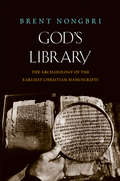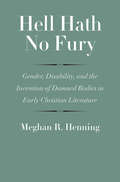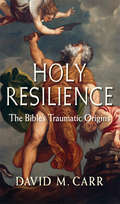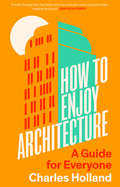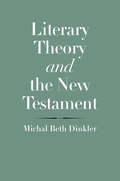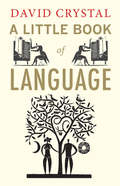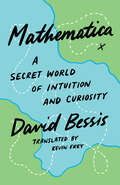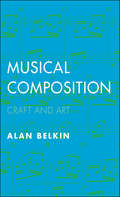- Table View
- List View
The Elements of Teaching: Second Edition
by James M. Banner Jr. Harold C. CannonA newly revised edition of this classic work, exploring the diverse qualities essential for teaching in today’s educational environment. According to Banner and Cannon, to be an effective teacher requires much more than technical skill. Great teaching is an art that combines a wide range of intellectual, moral, and emotional components. This classic work explores the qualities of mind and spirit that are essential for those seeking to help others acquire knowledge and understanding. It analyzes the specific qualities of successful teachers: learning, authority, ethics, order, imagination, tenacity, compassion, patience, character, and pleasure. Written in a clear and engaging style and applicable to all levels of teaching—be it in schools and universities or on athletic fields and in the home—the book encourages teachers to consider how they might enlarge their understanding of the great art of teaching.
Fictions of Art History (Clark Studies In The Visual Arts Ser.)
by Mark Ledbury Michael Hatt Paul Barolsky Professor Thomas Crow Gloria Kury Ralph Lieberman Maria H. Loh Alexander Nemerov Joanna Scott Cole Swensen Marianna Torgovnick Caroline Vout Marina WarnerFictions of Art History, the most recent addition to the Clark Studies in the Visual Arts series, addresses art history’s complex relationships with fiction, poetry, and creative writing. Inspired by a 2010 conference, the volume examines art historians’ viewing practices and modes of writing. How, the contributors ask, are we to unravel the supposed facts of history from the fictions constructed in works of art? How do art historians employ or resist devices of fiction, and what are the effects of those choices on the reader? In styles by turns witty, elliptical, and plain-speaking, the essays in Fictions of Art History are fascinating and provocative critical interventions in art history.
Free Speech on Campus
by Erwin Chemerinsky Howard GillmanCan free speech coexist with an inclusive campus environment? Hardly a week goes by without another controversy over free speech on college campuses. On one side, there are increased demands to censor hateful, disrespectful, and bullying expression and to ensure an inclusive and nondiscriminatory learning environment. On the other side are traditional free speech advocates who charge that recent demands for censorship coddle students and threaten free inquiry. In this clear and carefully reasoned book, a university chancellor and a law school dean—both constitutional scholars who teach a course in free speech to undergraduates—argue that campuses must provide supportive learning environments for an increasingly diverse student body but can never restrict the expression of ideas. This book provides the background necessary to understanding the importance of free speech on campus and offers clear prescriptions for what colleges can and can’t do when dealing with free speech controversies.
Friendship in the Hebrew Bible (The Anchor Yale Bible Reference Library)
by Saul M. OlyanThe first comprehensive study of friendship in the Hebrew Bible Friendship, though a topic of considerable humanistic and cross disciplinary interest in contemporary scholarship, has been largely ignored by scholars of the Hebrew Bible, possibly because of its complexity and elusiveness. Filling a significant gap in our knowledge and understanding of biblical texts, Saul M. Olyan provides this original, accessible analysis of a key form of social relationship. In this thorough and compelling assessment, Olyan analyzes a wide range of texts, including prose narratives, prophetic materials, psalms, pre-Hellenistic wisdom collections, and the Hellenistic-era wisdom book Ben Sira. This in-depth, contextually sensitive, and theoretically engaged study explores how the expectations of friends and family members overlap and differ, examining, among other things, characteristics that make the friend a distinct social actor; failed friendship; and friendships in narratives such as those of Ruth and Naomi, and Jonathan and David. Olyan presents a comprehensive look at what constitutes friendship in the Hebrew Bible.
God's Library: The Archaeology of the Earliest Christian Manuscripts
by Brent NongbriIn this bold and groundbreaking book, Brent Nongbri provides an up-to-date introduction to the major collections of early Christian manuscripts and demonstrates that much of what we thought we knew about these books and fragments is mistaken. While biblical scholars have expended much effort in their study of the texts contained within the earliest Christian manuscripts, there has been a surprising lack of interest in thinking about these books as material objects with individual, unique histories. We have too often ignored the ways that the antiquities market obscures our knowledge of the origins of these manuscripts. Through painstaking archival research and detailed studies of the most important collections of early Christian manuscripts, Nongbri vividly shows that the earliest Christian books are more than just carriers of texts or samples of handwriting. They are three-dimensional archaeological artifacts with fascinating stories to tell, if we’re willing to listen.
The Gospel of Judas: A New Translation with Introduction and Commentary (The Anchor Yale Bible Commentaries)
by David BrakkeA new translation and commentary on the extracanonical Coptic text that describes Judas’ special status among Jesus’ disciples Since its publication in 2006, The Gospel of Judas has generated remarkable interest and debate among scholars and general readers alike. In this Coptic text from the second century C.E., Jesus engages in a series of conversations with his disciples and with Judas, explaining the origin of the cosmos and its rulers, the existence of another holy race, and the coming end of the current world order. In this new translation and commentary, David Brakke addresses the major interpretive questions that have emerged since the text’s discovery, exploring the ways that The Gospel of Judas sheds light on the origins and development of gnostic mythology, debates over the Eucharist and communal authority, and Christian appropriation of Jewish apocalyptic eschatology. The translation reflects new analyses of the work’s genre and structure, and the commentary and notes provide thorough discussions of the text’s grammar and numerous lacunae and ambiguities.
Hell Hath No Fury: Gender, Disability, and the Invention of Damned Bodies in Early Christian Literature (The Anchor Yale Bible Reference Library)
by Meghan R. HenningThe first major book to examine ancient Christian literature on hell through the lenses of gender and disability studies Throughout the Christian tradition, descriptions of hell’s fiery torments have shaped contemporary notions of the afterlife, divine justice, and physical suffering. But rarely do we consider the roots of such conceptions, which originate in a group of understudied ancient texts: the early Christian apocalypses. In this pioneering study, Meghan Henning illuminates how the bodies that populate hell in early Christian literature—largely those of women, enslaved persons, and individuals with disabilities—are punished after death in spaces that mirror real carceral spaces, effectually criminalizing those bodies on earth. Contextualizing the apocalypses alongside ancient medical texts, inscriptions, philosophy, and patristic writings, this book demonstrates the ways that Christian depictions of hell intensified and preserved ancient notions of gender and bodily normativity that continue to inform Christian identity.
History of the Yale Law School: The Tercentennial Lectures
by Prof. Anthony T. KronmanThe entity that became the Yale Law School started life early in the nineteenth century as a proprietary school, operated as a sideline by a couple of New Haven lawyers. The New Haven school affiliated with Yale in the 1820s, but it remained so frail that in 1845 and again in 1869 the University seriously considered closing it down. From these humble origins, the Yale Law School went on to become the most influential of American law schools. In the later nineteenth century the School instigated the multidisciplinary approach to law that has subsequently won nearly universal acceptance. In the 1930s the Yale Law School became the center of the jurisprudential movement known as legal realism, which has ever since shaped American law. In the second half of the twentieth century Yale brought the study of constitutional and international law to prominence, overcoming the emphasis on private law that had dominated American law schools. By the end of the twentieth century, Yale was widely acknowledged as the nation’s leading law school.The essays in this collection trace these notable developments. They originated as a lecture series convened to commemorate the tercentenary of Yale University. A distinguished group of scholars assembled to explore the history of the School from the earliest days down to modern times. This volume preserves the highly readable format of the original lectures, supported with full scholarly citations.Contributors to this volume are Robert W. Gordon, Laura Kalman, John H. Langbein, Gaddis Smith, and Robert Stevens, with an introduction by Anthony T. Kronman.
Holy Resilience: The Bible's Traumatic Origins
by David M. CarrHuman trauma gave birth to the Bible, suggests eminent religious scholar David Carr. The Bible’s ability to speak to suffering is a major reason why the sacred texts of Judaism and Christianity have retained their relevance for thousands of years. In his fascinating and provocative reinterpretation of the Bible’s origins, the author tells the story of how the Jewish people and Christian community had to adapt to survive multiple catastrophes and how their holy scriptures both reflected and reinforced each religion’s resilient nature. Carr’s thought-provoking analysis demonstrates how many of the central tenets of biblical religion, including monotheism and the idea of suffering as God’s retribution, are factors that provided Judaism and Christianity with the strength and flexibility to endure in the face of disaster. In addition, the author explains how the Jewish Bible was deeply shaped by the Jewish exile in Babylon, an event that it rarely describes, and how the Christian Bible was likewise shaped by the unspeakable shame of having a crucified savior.
The House of the Mother: The Social Roles of Maternal Kin in Biblical Hebrew Narrative and Poetry (The Anchor Yale Bible Reference Library)
by Prof. Cynthia R. ChapmanA novel approach to Israelite kinship, arguing that maternal kinship bonds played key social, economic, and political roles for a son who aspired to inherit his father’s household Upending traditional scholarship on patrilineal genealogy, Cynthia Chapman draws on twenty years of research to uncover an underappreciated yet socially significant kinship unit in the Bible: “the house of the mother.” In households where a man had two or more wives, siblings born to the same mother worked to promote and protect one another’s interests. Revealing the hierarchies of the maternal houses and political divisions within the national house of Israel, this book provides us with a nuanced understanding of domestic and political life in ancient Israel.
How the Bible Became Holy
by Michael L SatlowIn this sweeping narrative, Michael Satlow tells the fascinating story of how an ancient collection of obscure Israelite writings became the founding texts of both Judaism and Christianity, considered holy by followers of each faith. Drawing on cutting-edge historical and archeological research, he traces the story of how, when, and why Jews and Christians gradually granted authority to texts that had long lay dormant in a dusty temple archive. The Bible, Satlow maintains, was not the consecrated book it is now until quite late in its history.He describes how elite scribes in the eighth and seventh centuries B.C.E. began the process that led to the creation of several of our biblical texts. It was not until these were translated into Greek in Egypt in the second century B.C.E., however, that some Jews began to see them as culturally authoritative, comparable to Homer’s works in contemporary Greek society. Then, in the first century B.C.E. in Israel, political machinations resulted in the Sadducees assigning legal power to the writings. We see how the world Jesus was born into was largely biblically illiterate and how he knew very little about the texts upon which his apostles would base his spiritual leadership.Synthesizing an enormous body of scholarly work, Satlow’s groundbreaking study offers provocative new assertions about commonly accepted interpretations of biblical history as well as a unique window into how two of the world’s great faiths came into being.
How the Gospels Became History: Jesus and Mediterranean Myths (Synkrisis)
by M. David LitwaA compelling comparison of the gospels and Greco-Roman mythology which shows that the gospels were not perceived as myths, but as historical records Did the early Christians believe their myths? Like most ancient—and modern—people, early Christians made efforts to present their myths in the most believable ways. In this eye-opening work, M. David Litwa explores how and why what later became the four canonical gospels take on a historical cast that remains vitally important for many Christians today. Offering an in-depth comparison with other Greco-Roman stories that have been shaped to seem like history, Litwa shows how the evangelists responded to the pressures of Greco-Roman literary culture by using well-known historiographical tropes such as the mention of famous rulers and kings, geographical notices, the introduction of eyewitnesses, vivid presentation, alternative reports, and so on. In this way, the evangelists deliberately shaped myths about Jesus into historical discourse to maximize their believability for ancient audiences.
How to Enjoy Architecture: A Guide for Everyone
by Charles HollandCharles Holland challenges us to look beyond the day-to-day familiarity of buildings to rediscover the pleasure of experiencing architecture Architecture is bound up with our daily lives but, for most of us, it is experienced as a blur of habit. Our reactions towards the buildings that surround us are often culturally generated, and we experience them in ways that are immediate but often mundane. How to Enjoy Architecture: A Guide for Everyone encourages us to move beyond this and, instead, really look at buildings. Renowned architect Charles Holland talks about the buildings and architects that excite and inspire him, and the ideas and principles through which we can engage with architecture. By breaking buildings down into categories such as materials, structure, space, and use, Holland guides us through drastically different styles and building types—from the satisfying symmetry of a Queen Anne house to the thrill of a high-tech tower, or the social ideals that lie behind a housing estate. In doing so, he demonstrates how looking at, experiencing, and using architecture can bring joy in itself. "A book that will enrich any encounter with a building, it made me want to look harder and be more curious. We are led playfully through the fundamentals of architecture so that we might enjoy the details and the poetry of buildings all the more. A walk through the city feels more fun and also more profound after reading this book." Grayson Perry, artist "We so often encounter architecture when it goes wrong, or offends us with its looks. Holland, though, is the perfect, clear-headed tour guide to help us appreciate it with newly sharpened senses and fall in love again – even those buildings we think we hate." Tom Dyckhoff, academic and broadcaster "An enlightening and urbane exploration of architecture that resonates beyond conventional chronological histories" Catherine Slessor, architecture writer and critic  
How to Enjoy Art: A Guide for Everyone
by Ben StreetAn entertaining and lively guide to rediscovering the pleasure in artHow to Enjoy Art: A Guide for Everyone provides the tools to understand and enjoy works of art. Debunking the pervasive idea that specialist knowledge is required to understand and appreciate art, instead How to Enjoy Art focuses on experience and pleasure, demonstrating how anyone can find value and enjoyment in art. Examples from around the world and throughout art history—from works by Fra Angelico and Berthe Morisot to Kazuo Shiraga and Kara Walker—are used to demonstrate how a handful of core strategies and skills can help enhance the experience of viewing art works. With these skills, anyone can encounter any work of art—regardless of media, artist or period—and find some resonance with their own experiences. How to Enjoy Art encourages us to rediscover the fundamental pleasure in viewing art.
An Introduction to the New Testament: The Abridged Edition (The Anchor Yale Bible Reference Library)
by Raymond E. Brown Marion SoardsSince its publication in 1997, Raymond Brown’s Introduction to the New Testament has been widely embraced by modern readers seeking to understand the Christian Bible. Acknowledged as a paragon of New Testament studies in his lifetime, Brown was a gifted communicator who wrote with ease and clarity. Abridged by Marion Soards, who worked with Brown on the original text, this new, concise version maintains the essence and centrist interpretation of the original without tampering with Brown’s perspective, insights, or conclusions. The biblical writings themselves remain the focus, but there are also chapters dealing with the nature, origin, and interpretation of the New Testament texts, as well as chapters concerning the political, social, religious, and philosophical world of antiquity. Furthermore, augmenting Brown’s commentary on the New Testament itself are topics such as the Gospels’ relationship to one another; the form and function of ancient letters; Paul’s thought and life, along with his motivation, legacy, and theology; a reflection on the historical Jesus; and a survey of relevant Jewish and Christian writings. This comprehensive, reliable, and authoritative guidebook is now more accessible for novices, general readers, Bible study groups, ministers, scholars, and students alike.
Learning Policy: When State Education Reform Works
by Professor David K. Cohen Professor Heather C. HillEducation reformers and policymakers argue that improved students’ learning requires stronger academic standards, stiffer state tests, and accountability for students’ scores. Yet these efforts seem not to be succeeding in many states. The authors of this important book argue that effective state reform depends on conditions which most reforms ignore: coherence in practice as well as policy and opportunities for professional learning.The book draws on a decade’s detailed study of California’s ambitious and controversial program to improve mathematics teaching and learning. Researchers David Cohen and Heather Hill report that state policy influenced teaching and learning when there was consistency among the tests and other policy instruments; when there was consistency among the curricula and other instruments of classroom practice; and when teachers had substantial opportunities to learn the practices proposed by the policy.These conditions were met for a minority of elementary school teachers in California. When the conditions were met for teachers, students had higher scores on state math tests. The book also shows that, for most teachers, the reform ended with consistency in state policy. They did not have access to consistent instruments of classroom practice, nor did they have opportunities to learn the new practices which state policymakers proposed. In these cases, neither teachers nor their students benefited from the state reform. This book offers insights into the ways policy and practice can be linked in successful educational reform and shows why such linkage has been difficult to achieve. It offers useful advice for practitioners and policymakers seeking to improve education, and to analysts seeking to understand it.
Learning Science: The Value of Crafting Engagement in Science Environments (Innovations In Science Education And Technology Ser. #13)
by Barbara Schneider Joseph Krajcik Jari Lavonen Katariina Salmela-AroAn innovative, internationally developed system to help advance science learning and instruction for high school students This book tells the story of a $3.6 million research project funded by the National Science Foundation aimed at increasing scientific literacy and addressing global concerns of declining science engagement. Studying dozens of classrooms across the United States and Finland, this international team combines large-scale studies with intensive interviews from teachers and students to examine how to transform science education. Written for teachers, parents, policymakers, and researchers, this book offers solutions for matching science learning and instruction with newly recommended twenty-first-century standards.
Literary Theory and the New Testament (The Anchor Yale Bible Reference Library)
by Michal Beth DinklerA comprehensive case for a fresh literary approach to the New Testament For at least a half century, scholars have been adopting literary approaches to the New Testament inspired by certain branches of literary criticism and theory. In this important and illuminating work, Michal Beth Dinkler uses contemporary literary theory to enhance our understanding and interpretation of the New Testament texts. Dinkler provides an integrated approach to the relation between literary theory and biblical interpretation, employing a wide range of practical theories and methods. This indispensable work engages foundational concepts and figures, the historical contexts of various theoretical approaches, and ongoing literary scholarship into the twenty-first century. In Literary Theory and the New Testament, Dinkler assesses previous literary treatments of the New Testament and calls for a new phase of nuanced thinking about New Testament texts as both ancient and literary.
A Little Book of Language (Little Histories)
by David CrystalWith a language disappearing every two weeks and neologisms springing up almost daily, an understanding of the origins and currency of language has never seemed more relevant. In this charming volume, a narrative history written explicitly for a young audience, expert linguist David Crystal proves why the story of language deserves retelling.From the first words of an infant to the peculiar modern dialect of text messaging, A Little Book of Language ranges widely, revealing language’s myriad intricacies and quirks. In animated fashion, Crystal sheds light on the development of unique linguistic styles, the origins of obscure accents, and the search for the first written word. He discusses the plight of endangered languages, as well as successful cases of linguistic revitalization. Much more than a history, Crystal’s work looks forward to the future of language, exploring the effect of technology on our day-to-day reading, writing, and speech. Through enlightening tables, diagrams, and quizzes, as well as Crystal’s avuncular and entertaining style, A Little Book of Language will reveal the story of language to be a captivating tale for all ages.
Mark 8-16 (The Anchor Yale Bible Commentaries)
by Joel MarcusIn the final nine chapters of the Gospel of Mark, Jesus increasingly struggles with his disciples’ incomprehension of his unique concept of suffering messiahship and with the opposition of the religious leaders of his day. The Gospel recounts the events that led to Jesus’ arrest, trial, and crucifixion by the Roman authorities, concluding with an enigmatic ending in which Jesus’ resurrection is announced but not displayed. In this volume New Testament scholar Joel Marcus offers a new translation of Mark 8†“16 as well as extensive commentary and notes. He situates the narrative within the context of first-century Palestine and the larger Greco-Roman world; within the political context of the Jewish revolt against the Romans (66†“73 C.E.); and within the religious context of the early church’s sometimes rancorous engagement with Judaism, pagan religion, and its own internal problems. For religious scholars, pastors, and interested lay people alike, the book provides an accessible and enlightening window on the second of the canonical Gospels.
Mark 8-16: A New Translation With Introduction And Commentary (The Anchor Yale Bible Commentaries)
by Joel MarcusIn the final nine chapters of the Gospel of Mark, Jesus increasingly struggles with his disciples’ incomprehension of his unique concept of suffering messiahship and with the opposition of the religious leaders of his day. The Gospel recounts the events that led to Jesus’ arrest, trial, and crucifixion by the Roman authorities, concluding with an enigmatic ending in which Jesus’ resurrection is announced but not displayed.In this volume New Testament scholar Joel Marcus offers a new translation of Mark 8–16 as well as extensive commentary and notes. He situates the narrative within the context of first-century Palestine and the larger Greco-Roman world; within the political context of the Jewish revolt against the Romans (66–73 C.E.); and within the religious context of the early church’s sometimes rancorous engagement with Judaism, pagan religion, and its own internal problems. For religious scholars, pastors, and interested lay people alike, the book provides an accessible and enlightening window on the second of the canonical Gospels.
Mathematica: A Secret World of Intuition and Curiosity
by David BessisA fascinating look into how the transformative joys of mathematical experience are available to everyone, not just specialists Math has a reputation for being inaccessible. People think that it requires a special gift or that comprehension is a matter of genes. Yet the greatest mathematicians throughout history, from René Descartes to Alexander Grothendieck, have insisted that this is not the case. Like Albert Einstein, who famously claimed to have “no special talent,” they said that they had accomplished what they did using ordinary human doubts, weaknesses, curiosity, and imagination. David Bessis guides us on an illuminating path toward deeper mathematical comprehension, reconnecting us with the mental plasticity we experienced as children. With simple, concrete examples, Bessis shows how mathematical comprehension is integral to the great learning milestones of life, such as learning to see, to speak, to walk, and to eat with a spoon. Focusing on the deeply human roots of mathematics, Bessis dispels the myths of mathematical genius. He offers an engaging initiation into the experience of math not as a series of discouragingly incomprehensible logic problems but as a physical activity akin to yoga, meditation, or a martial art. This perspective will change the way you think not only about math but also about intelligence, intuition, and everything that goes on inside your head.
Mathematics for Human Flourishing
by Francis SuAn inclusive vision of mathematics—its beauty, its humanity, and its power to build virtues that help us all flourish For mathematician Francis Su, a society without mathematical affection is like a city without concerts, parks, or museums. To miss out on mathematics is to live without experiencing some of humanity’s most beautiful ideas. In this profound book, written for a wide audience but especially for those disenchanted by their past experiences, an award†‘winning mathematician and educator weaves parables, puzzles, and personal reflections to show how mathematics meets basic human desires—such as for play, beauty, freedom, justice, and love—and cultivates virtues essential for human flourishing. These desires and virtues, and the stories told here, reveal how mathematics is intimately tied to being human. Some lessons emerge from those who have struggled, including philosopher Simone Weil, whose own mathematical contributions were overshadowed by her brother’s, and Christopher Jackson, who discovered mathematics as an inmate in a federal prison. Christopher’s letters to the author appear throughout the book and show how this intellectual pursuit can—and must—be open to all.
Micah: A New Translation with Introduction and Commentary (The Anchor Yale Bible Commentaries)
by Bob BeckingA new translation and commentary on the biblical book of Micah that proposes a convincing new theory of its composition history While the biblical book of Micah is most famous for its images of peace—swords forged into to plowshares, spears turned into pruning hooks—and its passages of prophetic hope, the book is largely composed of prophecies of ruin. The historical Micah, who likely lived in the late eighth century BCE, is the first recorded prophet to predict the fateful fall of Jerusalem, and he also foretells the destruction of the regions of Samaria and Judah, in addition to the more well-known promises of Judah’s eventual restoration. Bob Becking translates the Hebrew text anew and illuminates the book’s most important elements, including its literary features, political context, and composition history. Drawing on ancient Near Eastern comparative evidence, archaeological notes, and inscriptions, Becking surveys the debates surrounding the book’s interpretation and argues that it be regarded as three separate source texts: the early first chapter; a large middle section containing a proto-apocalyptic, alternating prophetic futurology collected and molded by a later redactor; and an added section advocating for legal reform under Josiah.
Musical Composition: Craft and Art
by Alan BelkinAn invaluable introduction to the art and craft of musical composition from a distinguished teacher and composerThis essential introduction to the art and craft of musical composition is designed to familiarize beginning composers with principles and techniques applicable to a broad range of musical styles, from concert pieces to film scores and video game music. The first of its kind to utilize a style-neutral approach, in addition to presenting the commonly known classical forms, this book offers invaluable general guidance on developing and connecting musical ideas, building to a climax, and other fundamental formal principles. It is designed for both classroom use and independent study.




